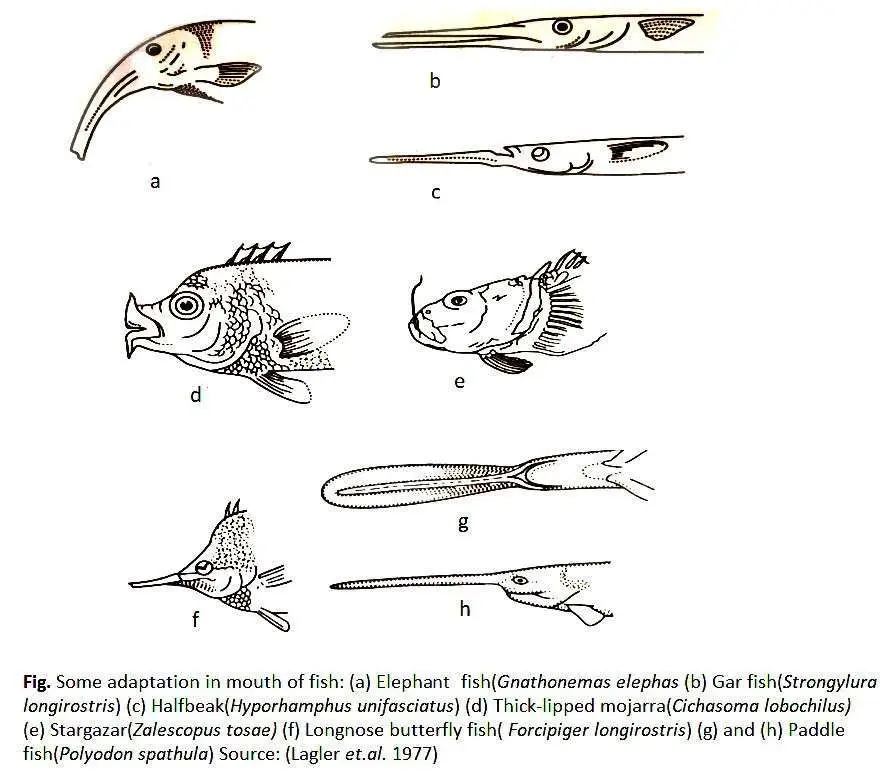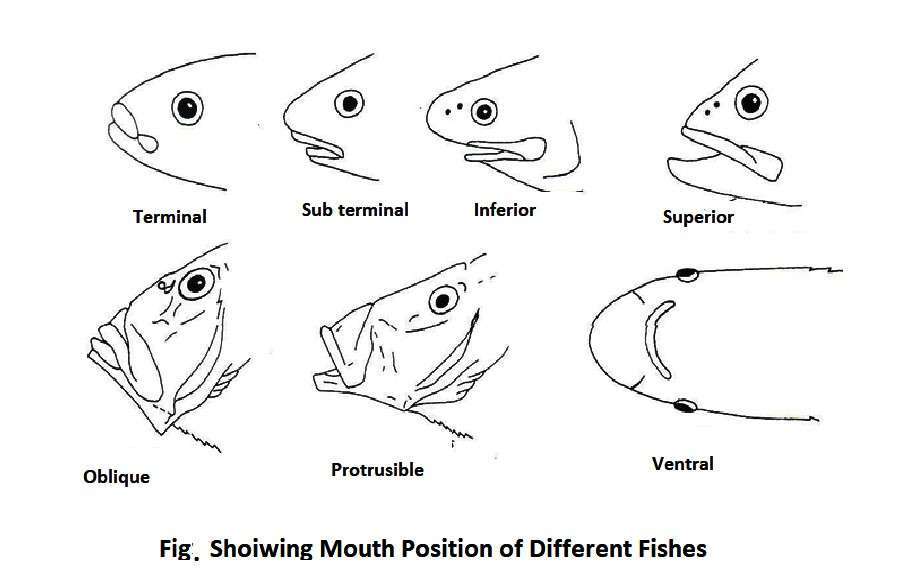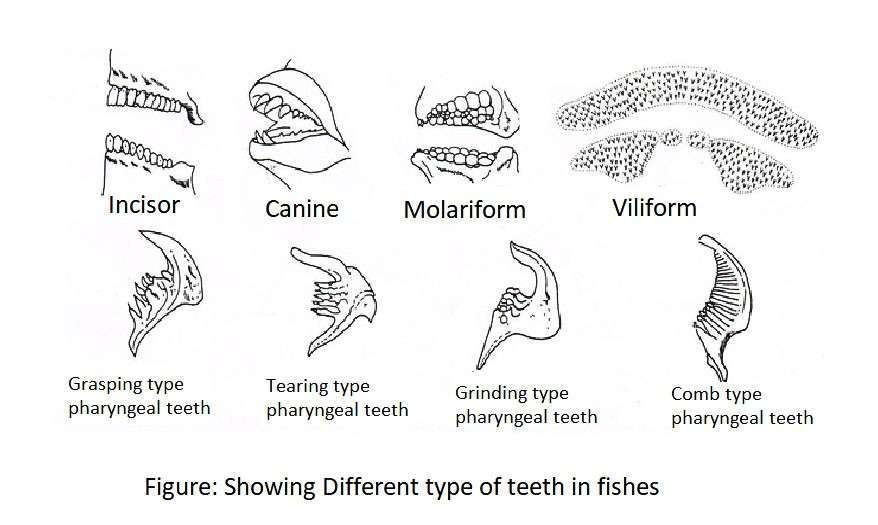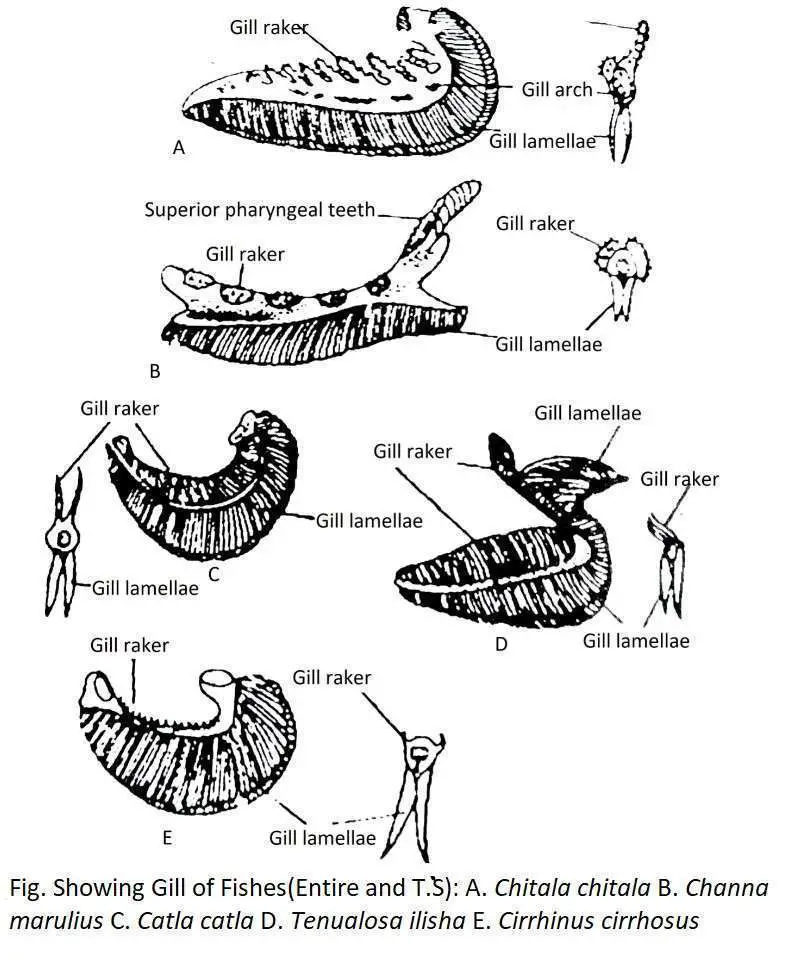As a result of evolution, fish has gained structural adaptation to take food in different conditions due to the diversity of fish diet. Fish take food from the natural environment. Different types of fish eat different types of food so their food list is much larger. The way and method of taking food depends on the diet and feeding habits.
Feeding Adaptation of Fishes
Different types of changes have been made in the digestive system of fish due to different diets. This change in the body’s ability to take food is called feeding adaptation. The lips, mouth, teeth, gills and digestive tract are modified and adapted based on the diet. These are described below:
Modification of Lips
Eating habits can cause structural changes in the lips of fish. Different types of lip structure are described below:
1. Thin lip: Fish that eat large foods have very stiff jaws and thin, unaltered lips such as Xenentodon.
2. Thick and Fleshy lip: The fishes that take food by sucking, they have thick and fleshy type lip. Carp (Cyprinidae) have thick and fleshy lip so they can bite or suck.
You might also read: Osmoregulation in Fishes
3. Transformation into Hold fast Organ: Free-living Sisorid catfish in Asia, some South American catfish (Loricaridae), Loach-like Gyrinocheilid (Gyrinochilus) of Southeast Asia have sucktorial lips. Gyrinochilus has separate water entry and exit techniques in the operculum so they do not have to breathe through their mouth while they are engaged in food sucking. In parasitic lampreys (Petromyzonidae) and Hagfish (Myxinidae), the jawless sucking mouth also acts as a holdfast organ for attachment to the host and a food-extracting organ from the host. Moreover the sucking mouth of the lamprey can remove stones.
As the lips of the fish have changed due to feeding habits, so has the mouth. Such changes are seen in Gazers and Suctorial Feeders. The following are the descriptions of different types of mouth of fish:
1. Predatory Mouth: The mouth is large, the jaw is stiff and both jaws have sharp teeth. The mouth expands and swallows the prey. In freshwater shark (Wallago attu) and deep sea predatory fish such as viper fish (Chauliodus), this type of mouth is seen.
2. Sucking Mouth: This type of mouth is round, funnel shaped. There is no jaw in the downward mouth. The tongue has numerous small teeth. Example- Petomyzon marinus.
3. Absorbing mouth: This type of fish’s mouth is like a tube. Such a mouth does not have teeth. The mouth is extending outwards. They eat small animals at the bottom of reservoirs as food such as pipe fish– Syngnathus.
4. Grinding mouth: This type of mlouth looks like the lips of an aquatic bird. The jaw contains hard and sharp teeth. Such fish can eat by breaking food or in pieces. Example- Xenentodon cancila
5. Plankton Feeder Mouth: This type of mouth is suitable for eating plankton. The mouth is large or medium type. Jaws are soft with no teeth in mouth. Their gill raker is densely embedded to form a sieve-like structure. Example- Tenualosa ilisha, Hypophthalmicthyes molitrix, Catla catla.
Special type of Mouth: Special type of mouths are of three types, viz
1. Half beak: In such a mouth, the lower jaw is long and the upper jaw is short. The teeth are small which are suitable for taking small foods on the surface of the water. Example: Hyporhamphus gaimerdi
2. Paddle like Mouth: The upper jaw of this type of fish is extended but the lower jaw is short. It moves the mud from the bottom with a spoon-shaped beak and finds small creatures and eats them. Example: Paddle fish-Polyodon spathula.
3. Protrusive Mouth: The pre-maxillary bones of some fish are attached to other bones in front of the skull in such a way that they can project at will. Such an enlarged mouth increases the space inside the mouth compared to other fish. This type of fish with a mouth is predatory in nature. Example: Nandus nandus.
Position by Mouth
Position by mouth is divided into the following distinct parts, e.g.
1. Superior Mouth: In such a mouth, the lower jaw is larger and the upper jaw is smaller. The mouth is located diagonally upwards. Such mouth can be seen on plankton-eating fish living on the surface of the water. Example: Catla-Catla catla, Silvercarp-Hypophpthalmicthyes molitrix, Pabda catfish-Ompok pabda
2.Terminal mouth: In this case, the position of the mouth is almost parallel to the body. Such mouth-fed fish eat surface and mid-surface food. Example: Puffer fish-Tetradon cutcutia.
3. Sub-terminal Mouth: In this case, the mouth opening is located below the upward mouth opening and slightly above the lateral mouth opening. Example: Rohu- Labeo rohita.
4. Inferior Mouth: In this case, the upper jaw is large and the lower jaw is very small. Such fish eat the food from the bottom. Example: Mrigel fish – Cirhinnus cirrhosus
5. Ventral Mouth: The mouth of such is located on the ventral surface. Such mouth can be seen in many teleosts and elasmobranchs. Example: Wallago attu, Scoliodon laticaudus.
6. Semi-ventral Mouth: Such a mouth is not located in a completely ventral position. As a result of the development of fleshy lips, it has taken a ventral position. Example- Conta conta.
Modification in the Teeth
There have been special changes in the teeth of fish for eating. The positional and morphological changes of the teeth are significant in this case. In chondrichthyes, placoid scales are transformed into teeth. Depending on where it is found, teeth of bony fish can be divided into the following three types:
(1) jaw,
(2) mouth and
(3) pharynx.
1. Jaw Teeth
These teeth are located in the maxillary, pre-maxillary and dentine bones of fish. Such toothed fish are predatory in nature. Example: Channa striatus
Also the jaw teeth are divided into five types based on the shape, viz
(1) Cardiform: They are many in number, short and small but pointed. There is a pad of teeth on a bone. Such fish eat plankton, soft plants and small animals. Such teeth are found in North American catfish (Ictaluridae), Perch (Percidae) and seabass (Serranidae).
(2) Villiform teeth: Such teeth look like intestinal villi but are a little longer which helps to hold food. Such toothed fish eat zooplankton, plants and small fish. Examples: Xenentodon cancila, Pterois miles.
(3) Canine teeth: These teeth are like dog teeth. In most cases, they are look a venom tooth of snake. These are elongated, conical, curved, and pierced. Predatory fish have such teeth. They take small animals and small fish as food. Example- Whitespotted moray (Gymnothorax punctatus), Deep sea viper (Chauliodus solani).
(4) Incisor teeth: These are cutting teeth with sharp edges. In some fishes, these are human-like teeth. Such toothed fish are usually accustomed to crushing aquatic weeds, crustaceans and molluscs. E.g. Rainbow parrot fish (Sarus guacamaia).
(5) Molariform teeth: These teeth are suitable for grinding and crushing. These are flat and wide. Such teeth can be seen in the fish living at the bottom. Examples: Skates (Dasyatis), Chimaera (Holocephali).
2. Mouth Teeth
This type of tooth is seen in parasitic fish. It is funnel type mouth which does not have a jaw. There are small teeth inside the mouth. Example- Petromyzon marinus.
3. Pharyngeal Teeth
Different fish have a few sets of teeth of different shapes in the pharyngeal region. Such teeth are used for grinding. It is again of four types, viz:
(1) Grasping type: Such teeth are used to grasp food such as Puntius has such teeth;
(2) Tearing type: This type of tooth helps in breaking food. It is seen in rudd (Scardinius);
(3) Grinding type: This type of tooth is used for grinding food. It is found in Cyprinus carpio.
(4) Comb like– This type of tooth is used to filter food. It is found in golden redhorse -Moxostoma erythrurum.
Fish Jaws
Fish have two types of jaws, the upper jaw is called the maxilla and the lower jaw is called the mandible. Fish jaws can be divided into three types based on the presence of teeth, viz:
(1) Teeth jaw: The jaws of such fish are hard and sharp-toothed. These fish eat plankton or zooplankton and small fish, such as Xenentodon cancila.
(2) Cut edged jaw: The jaws of this type of fish have no teeth but the edges are sharp. This type of fish eats plant by cuttings, such as grass carp – Ctenopharyngodon idellus.
(3)Toothless jaw: This type of fish has no tooth on jaws and they eats phytoplankton, zooplankton and aquatic plants, such as Labeo rohita.
Dentition
There is a deep connection between eating habits and the food consumed. In predatory fish such as pike (Esox), gar (Lepisosteus) and deep sea gulper, they have sharp pointed teeth which help to catch prey. The toothless jawed fish eats plankton and periphyton (Swallowers-Saccopharyngoidae). Skates (Rajidae) and drums (Sciaenidae) have molariform teeth in the oral or pharyngeal cavity that help to eat snails, clams, oysters, crustaceans.
Razor-like incisors teeth are found in predatory fish, especially piranhas (Serrasalmus) and warm-sea barracuda (Sphyraena). Some herbivorous fish (Parrot fish-Scaridae) have teeth in their jaws and gills. The teeth of the jaw come together to break the food into pieces, and the crushed teeth of the pharynx turn the pieces of food into fine particles.
Plankton eaters have no teeth in their mouths. However, some omnivores do not have teeth. The number of bones is gradually increasing in predatory fish. Teeth are seen in the premaxillary bone in most fish with teeth. Similar conditions are observed in Bofin (Amia), Gar (Lepisosteus), Salmon and Trout (Salmoninae) and Perciformes. Fish with soft fins have pre-maxillary and maxillary teeth. Spiny ray-finned fish do not have maxillary teeth.
Modification of Gill Rakers
The primary function of the gill rakers is to protect the gill filaments from injury. However, they also help in eating fish. Carnivorous fish (Wallago attu, Chitala chitala (= Notopterus chitala), Channa marulias, C. striatus, Herpodon nehereus, Mystus seenghala) have usually long hard teeth and they form rasping organs. However, in some fish such as Trichiurus, these are reduced to form small granular structures.
Muraenesox does not contain any gill rakers. In some omnivorous species such as Tor tor, Puntius sarana, P. ticto, etc., the gill rakers are short and thick. In herbivorous fishes such as Ruhu (Labeo rohita), Mrigel (Cirrhina cirrhosus), Catla (Catla catla), the gill raker forms a wide sieve-like organ. The mouth cavity selects food particles by filtrating water into the pharyngeal region. This condition is more developed in plankton-eating fish such as Tenualosa ilisha, Gudusia chapra, Engraulis japonicum. The gill rakers of these fish are long and they select zooplankton and phytoplankton as food in the mouth cavity region.
However, some fish, such as Boleopthalmus and Syngnathidae, are plankton-eating, despite the presence of decaying gill rakers. In this way, the gill raker picks up the food particles and arranges the food through the gill pouches so that the food does not go away from the mouth. This filtration efficiency increases in omnivores from carnivores and is highest in herbivores. Different fish vary in number and size of gill rakers. However, due to different ecological niches, in the fish of the same species, the gill rakers are also different.
Types of Gill Rakers
Depending on the position, gill rakers can be divided into three categories, viz.
(1) Short gill raker: This type of gill raker is usually found in predatory fish;
(2) Medium sized gill raker: Such gill racker exists in omnivorous fish;
(3) Large and comb like gill raker: The fishes that take food by seiving, they have this kind of gill raker.
You might also read: Fish food types based on food intake




